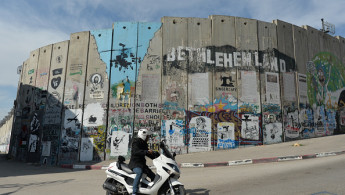Anger as Banksy painting sprayed in West Bank resurfaces in Tel Aviv
A long-lost painting by the British graffiti artist Banksy has resurfaced in a swank art gallery in downtown Tel Aviv, an hour’s drive and a world away from the concrete wall in the occupied West Bank where it was initially sprayed -- a move Palestinians have branded as theft.
The relocation of the painting — which depicts a slingshot-toting rat and was likely intended to protest the Israel occupation — raises ethical questions about the removal of artwork from occupied territory and the display of such politically-charged pieces in radically different settings from where they were created.
The painting initially appeared near Israel’s separation barrier in the occupied West Bank city of Bethlehem and was one of several works created in secret around 2007. They employed Banksy’s trademark absurdist and dystopian imagery to protest Israel’s decades-long occupation of the occupied West Bank.
Now it resides at the Urban Gallery in the heart of Tel Aviv’s financial district, surrounded by glass and steel skyscrapers.
“This is theft of the property of the Palestinian people,” said Jeries Qumsieh, a spokesperson for the Palestinian Tourism Ministry. “These were paintings by an international artist for Bethlehem, for Palestine, and for visitors to Bethlehem and Palestine. So transferring them, manipulating them and stealing them is definitely an illegal act.”
“This is the story of David and Goliath,” said Koby Abergel, an Israeli art dealer who purchased the painting, without elaborating on the analogy. He said the gallery was simply displaying the work, leaving its interpretation to others.
The 70-kilometer (43-mile) journey it made from the occupied West Bank to Tel Aviv is shrouded in secrecy. The 900-pound concrete slab would have had to pass through Israel’s serpentine barrier and at least one military checkpoint — daily features of Palestinian life and targets of Banksy’s biting satire.
The graffiti artwork was spray-painted on a concrete block that was part of an abandoned Israeli army position in Bethlehem, next to a soaring concrete section of the separation barrier.
It was not possible to independently confirm his account of its journey.
The piece now stands on an ornately patterned tile floor, surrounded by other contemporary art. Baruch Kashkash, the gallery’s owner, said the roughly 2-square-meter (-yard) block was so heavy it had to be brought inside by a crane, and could barely be moved from the doorway.
Israel's illegal occupation means it controls all access to the occupied West Bank, and Palestinians require Israeli permits to travel in or out and to import and export goods.
Abergel claimed the artwork’s move was not coordinated with the Israeli military, and that his Palestinian associates, whom he declined to name, were responsible for moving it into Israel and crossing through military checkpoints. He said he has no plans to sell the piece.
According to the international treaty governing cultural property to which Israel is a signatory, occupying powers must prevent the removal of cultural property from occupied territories. It remains unclear exactly how the 1954 Hague Convention would apply in this instance.





 Follow the Middle East's top stories in English at The New Arab on Google News
Follow the Middle East's top stories in English at The New Arab on Google News


